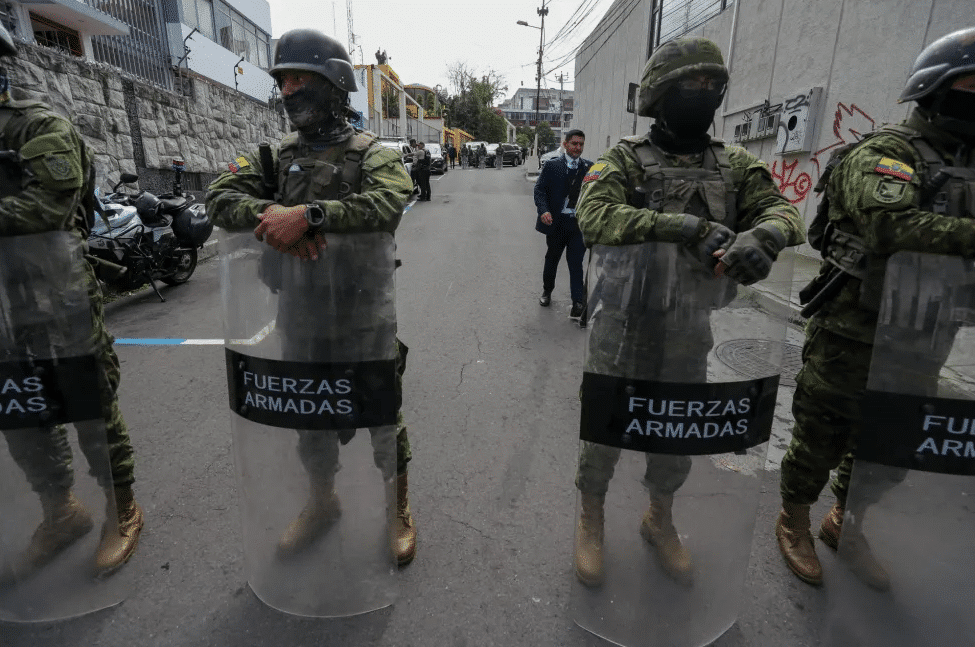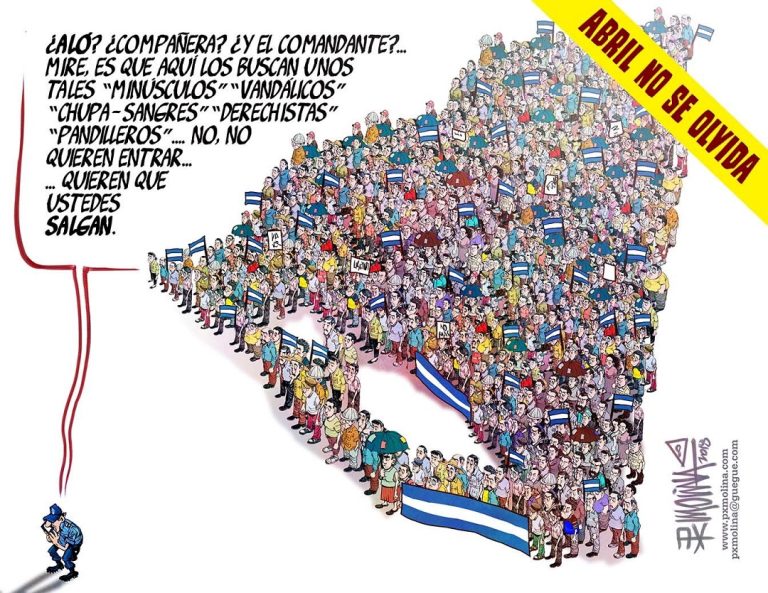28 de abril 2023

The Return of the Military

PUBLICIDAD 1M
PUBLICIDAD 4D
PUBLICIDAD 5D
Since that April, everything has changed so drastically that today we can say that April 19 marks another parting of the waters in our history

They say that when History with a capital H happens, it enters everyone’s home. That’s what happened in Nicaragua five years ago. Since that April, everything has changed so drastically that today we can say that April 19 marks another parting of the waters in our history: a before and after, like July 19, 1979, and February 25, 1990. There’s not a single Nicaraguan who doesn’t know where they were on that date. On both the macro and the micro levels, both generally and personally, everything changed. History entered our homes, and turning back is no longer possible. As a friend put it: “That country won’t return.”
Nothing has been the same again
In Nicaragua, nothing has been the same since then. Five years and 355 assassinations later, and the exile or banishment of 300,000, a little over 5% of the national population, leaving counties, villages and neighborhoods depopulated, it’s another country. Five years ago, Nicaragua’s greatest peacetime human rights crisis unfolded, and apparently it hasn’t yet reached bottom. The persecution of the Catholic religion, the expulsion of priests, the imprisonment of Monsignor Alvarez, the confiscation of convents, the absurd forbidding of Easter Week religious processions, and the latest arbitrary imprisonments all demonstrate that the dictatorship’s appetite for repression has still not been satiated. There’s no more daily bread; instead, they prescribe the daily prison sentence.
The government changed
As a report from the UN’s Group of Human Rights Experts on Nicaragua states, the Nicaraguan government didn’t begin committing serious human rights violations in 2018, but beginning that year it was transformed into a set of interconnected apparatuses all aimed at implementing, “a discriminatory policy to systematically persecute and silence each person, and to dismantle any civic or political organization that maintained postures differing from the government policies, or that could be perceived as critical or adversarial towards them.” With this, the government took definitive steps towards being a body that, instead of fulfilling its obligations to protect its people from abuses and violations, was (and continues being) the principal perpetrator, by commission and omission, of these horrendous crimes.
Society changed
The social explosion of 2018 rattled all the foundations of Nicaraguan society that suddenly found a channel for expressing their rage, after over 11 years of abuses and affronts. The fear so long bottled up broke through the restraints that had held it bound into a lethargy that resembled apathy. Everything burst apart: the sports stadiums full of people; the wild parties of every weekend; and the “I don’t get involved in anything because politics doesn’t put food on my table.” That same population poured out onto the streets in human floods, unaware that months later many would find themselves forced to emigrate. If there’s one feature where the profound change in society can be seen, it’s the phenomenon of exile, especially in Costa Rica. It’s the clearest picture that we’re a broken society – broken by separation, by pain and by the destruction of thousands of life projects.
And the economy changed
Despite the economic recovery of 2021 and 2022 after two years of negative growth, a recovery that’s been reported by official sources with no independent verification, the economy also changed. One change was the end of external aid, the result of the donor countries’ repudiation of the repression and of the dictatorship’s implementation of an isolationist foreign policy, leading them to break off relations with some. One sector in which this change has been very evident has been tourism. Prior to 2018, promising perspectives for tourism were being opened, fueled by marketing Nicaragua as the safest country in Central America. Then, in a little over a year, Nicaragua began figuring among the most unsafe and least legally trustworthy countries for foreign investment.
The political parties changed
As couldn’t have been otherwise, the rebellion passed right over the political parties. They were left isolated and out of place. For that reason, they were incapable of capitalizing on the protests, nor did they have a presence at the dialogue table. Instead, they found themselves forced to hitch themselves like cabooses to the Civic Alliance or the Blue and White Unity, platforms made up of the dozens of groups that arose in the heat of the protests. The pitiful internal disputes of 2021 and the subsequent repressive waves finished off the work of demolition. Today, the parties are ruins, shipwrecked boats, initiatives that join in collective sessions to lick their wounds, but nothing more. Five years later, each one says the other is worse, and they’re all right.
The political culture changed
Given the crisis of the political parties, the phenomenon of self-organization arose, the greatest catalyst the Nicaraguan political culture has seen in recent times. Five years ago, first-person participation and direct action were transformed into values that replaced the traditional calls to mobilize issued by the political and social organizations. The new dynamic utterly pulverized the notion of representation as the source of political legitimacy. Paradoxically, the questioning of representation continues to be one of the stones under the wheels of the movement for unity. Similarly, during these five years, the idea has crystalized that human rights is a cardinal value of political culture, that no one would dare to marginalize in political agreements.}
Civil society has changed
Of course, civil society has also changed. The generalized mobilization of the population in 2018 also occurred at the margins of the civil society organizations that were known at the time. This opened the doors to a new type of civil society organization, following the format of other protests that had occurred previously in Latin America. The autonomous structure wasn’t oriented so much towards internal organization, as towards its level of mobilization around the hub of political change. Seen that way, the birth of this new civil society occurred live and in the public space, with all the liberated energy. However, it also contained all the weaknesses derived from the other face of civil society – as a space of conflict among its different currents and agendas. Finally, it’s impossible to ignore the impact of the disappearance of the associative tissue of over 3,000 non-profit organizations of different natures that were shuttered by the regime.
The dictatorship changed
The dictatorship’s project also changed. The protests forced the collapse of the dialogue and consensus model upon which the dictatorship was trying to construct their hegemonic project, and obligated them to opt for pure, hard domination. The result was to transform their entire apparatus for mobilization into instruments of repression. That meant transforming the corporate bodies of the government and its agents, the Sandinista Youth, the National Union of Nicaraguan University Students, the labor unions and the Citizens’ Power Councils into gears of the State and non-State violence, turning them into paramilitary, with the addition of active-duty police without uniform and ex-military.
The way of living changed
This repressive regime and its decision to jail and banish anyone, also changed the way of life in Nicaragua. There are changes in sociability, due to the loss of friends who have gone into exile or have emigrated in search of a better life. There are forced changes in the job market, out of fear that certain professions may be among those criminalized by the regime, such as sociologists, journalists, doctors, performers, among others. Distrust among neighbors, among the people in a line, on the bus, among those at the neighboring table, and even among the members of a family. In short, destructive changes in the foundations of what is known as the country’s social capital.
The opportunity for change
The April deluge, like all crises, also opened windows of opportunity. The sharpening of the contradictions with the dictatorship has also situated us before better horizons than prior to 2018. From disaffection, we’ve gone on to commitment, and from silence to the testimony of all, every day and anywhere. There are no historic changes that don’t bring opportunities to end the tyranny.
In the words of Eduardo Galeano: “No history is mute. It doesn’t matter how much they burn it, shred it and lie about it, human history refuses to shut its mouth.”
This article was originally published in Spanish in Confidencial and translated by Havana Times

PUBLICIDAD 3M
Politólogo y sociólogo nicaragüense, viviendo en España. Es municipalista e investigador en temas relacionados con participación ciudadana y sociedad civil.
PUBLICIDAD 3D